#contagion pp
Explore tagged Tumblr posts
Text
If, as Isaac West observes, use of the public bathroom is “one of the most, if not the most, quotidian practices of citizenship,” then this chapter argues that surveillance criminalizing public bathroom use is one element of a larger effort to secure citizenship and spatial belonging through the apprehension of physical difference. [...]
Writing about the concept of civilization in the late nineteenth-century United States, Gail Bederman describes it as an “explicitly racial concept” that “denoted a precise stage in human racial evolution”: one that had evolved past primitive or barbaric characteristics. Drawing on Darwinism, this logic rationalized white supremacy through claims that people of color simply had not developed in the same ways or at the same rate as white people, situating civilization itself as a racial characteristic and producing and solidifying distinct racial categories. Bederman notes that gender was crucial in distinguishing civilized societies from the less advanced, with the former identified in part by clear binary gender divisions. [...] Moreover, in the era of formal Jim Crow, while bathrooms marked for white people were typically separated into men’s and women’s spaces, those labeled “colored” were often unmarked by gender at all, a practice that aligns with civilizational discourse. [...]
Yet citizenship status and gender status cannot be pulled apart [...]: just as the previous two chapters of this book traced specific aspects of the Department of Homeland Security that produce and rely on a gendered citizenship, we might consider how campaigns for neighborhood safety and family values regularly invoke a kind of good citizenship that is determined in part through gender attributes. [...]
We need only consider the emphasis on birth certificates to understand the extent to which anxieties about citizenship undergird these bathroom scenes, since those documents mark not only state-approved sex designation, but also legal citizen status. In the most formal sense, birth certificates purportedly confirm citizenship and thus one’s legal belonging to the nation-state. At the same time, they can serve as evidence of citizenship in a more informal or cultural sense: if producing appropriate paperwork is one way of complying with state regulations and requests, then doing so performs good citizenship. [...]
Discourses of bathroom contagion merge fears of “real germs” with “the fear of the other”; hence, public toilets provoke more anxiety than other germ-riddled public objects like computer terminals and doorknobs. Concerns about bathroom cleanliness are as much about bodily interactions and the difficulty of regulating public space as they are about actual dirt or waste. The racial integration of some U.S. workplaces during World War II, for example, prompted tremendous white anxiety about shared bathrooms, even as Black people had long cleaned toilets and beds, prepared food, and cared for children as part of their domestic work in white households. But this “private service work reinforced racialized gender hierarchies in ways that public intimacy undermined them.”
— Toby Beauchamp (2019), Going Stealth: Transgender Politics and US Surveillance Practices, pp. 81 - 101
In his book, Beauchamp argues that anti-trans bathroom bills should be understood as a form of state surveillance that is inextricable from anti-immigration and border security practices: these bills deputize members of the public to conduct bodily assessments of other people to determine whether they meet the criteria of a 'good citizen,' giving them the power to report 'fraudsters' to the authorities if a transgender person is found inhabiting a public bathroom. The criteria by which these assessments are conducted are explicitly white supremacist ones; not only because the imagined body of the 'good citizen' is one that reflects the ideals of white, bourgeois, cissexual bodies* (as clearly demarcated, binary gender roles is a sign of advanced white civilization, and perversion of these demarcations is a perversion of white civil life), but also because one of the primary forms of evidence that you belong in a gender-segregated public space (such as a bathroom) is a birth certificate, one issued by the state - as he says: "if producing appropriate paperwork is one way of complying with state regulations and requests, then doing so performs good citizenship." (p 93). Beauchamp criticizes the framing that trans people are treated like "second class citizens," as it accepts the white racial imaginary of (white) trans people being unfairly denied the benefits of full white citizenship; we should therefore understand gender segregated spaces not as a "remix" of "old" "historic" forms of racial segregation, but as a contemporary enforcement mechanism of it. Binaohan emphasizes this in their 2014 book Decolonizing Trans/Gender 101, arguing that non-white trans people are always "in public," denied any sort of private realm; they are always visible and marked as potential threats to white citizenship. (p. 39)
This is likewise reflected in Jenny Evang's 2022 work Is Gender Ideology Western Colonialism?, where she argues that anti-trans discourse situates the presumed natural state of 'sex' as being corrupted by an overly decadent form of Western cultural advancement, which is both degenerating the Western world and 'duping' the Global South into forsaking their relationship with nature, an argument that "[frames] “non-Western societies” as “more traditional” when it comes to gender, sexuality, and the family, since “gender ideology” has not yet gone as far there as in the West. Thus their argument relies on essentializing the very same conceptualization of “cultural difference” that structures femonationalist arguments in the first place, namely, that racialized, imagined elsewheres are stuck in a more traditional gender pattern, unable to keep up with the rampant development of the West." (p. 370). Locating the origin of transgenderism in the West reproduces notions of civilizational development, where the West is secure in its supreme cultural position but has merely gone "too far," "in the wrong direction," creating the circumstances of its own downfall - a downfall which is attributed both to mass immigration (particularly immigration of Muslims) and Marxism. (p. 372)
Fears of 'gender ideology' engulfing the Western world are inextricable from concerns about the maintenance of white social hygiene, as 'gender ideology' has been called "Ebola from Brussels" (p. 371), linking the corruption of binary, hierarchical, cissexual gender to a disease afflicting the body-politic of the white nation-state. The last paragraph of the quoted passage above from Beauchamp further demonstrates the fundamental interconnectedness between race, gender, and hygiene: The racial integration of some U.S. workplaces during World War II, for example, prompted tremendous white anxiety about shared bathrooms, even as Black people had long cleaned toilets and beds, prepared food, and cared for children as part of their domestic work in white households. But this private service work reinforced racialized gender hierarchies in ways that public intimacy undermined them." (p. 101) Discourses regarding public hygiene are civilizational discourses, as a clean world is a civilized world, and a civilized world can only be a white world.
*Beauchamp explicitly brings up that one of the 'problems' of using biometric data to scan the public for potential terrorists or 'fraudulent citizens' is the white inability to tell the difference between people belonging to different racial groups, i.e., the idea that all non-white people look too much alike and therefore must undergo even more intense scrutiny (p. 95).
97 notes
·
View notes
Text
Sunday, 25 August, 2024.
Class is at 1 PM. It will be HOT and dry.
Miss Esther was your Coach.
Warmup #1
Big Shane led you in some mobility exercises.
Warmup #2
50 Ab-Mat Sit-ups with Med-Ball
or GHD's 15 / 15 / 15
Strength
Military Press..........2 / 2 / 2 / 2
Push Press.........3 / 3 / 3 / 3
MP / PP
Bernie=155 / 185.....Shane=145 / 185.....Ed=125 / 165 Nathan=125/145.....Herb=115 / 115.....Tim=105/135.....Tom=100/115 Cheri=80/90 .....Alicia=75/95.....Linda=70 / 70.....Sue=65/75 Nathalie=55/65.....Maddi=55/55.....Jackie=45/55.....Sandy=35/45 Average Dave/Chris=did something
WOD
400 Body-weights
SOLO..........Vested ?
Run 400 / Row-Ski 500 / Bike 1000m
40 / 30 / 20 / 10
Pull-Ups
Push-Ups
Squats
Back Raises
Run 400 / Row-Ski 500 / Bike 1000m
LHCF Record
Larry: 15:10 (no one was vested)
December 2021
Bernie=17:55 (1/2).....Sue=18:19.....Nathan=18:54 (1/2).....Alicia=19:12 (3/4).....Shane=20:07 (RX).....Herb=22:10.....Tim=22:12 RX Tom=22:45.....Ed=25:39.....Nathalie=28:04.....Sandy=28:50 Jackie=33:00 (extra runs)..... Chris/Linda/Cheri/Average Dave/Maddi (1/3)=did something Coach=present
Notes:
Jackie brought Daughter Nathalie, who does volleyball at BHS and attends a gym that has obviously exposed her to barbells. Jackie should be very proud of Nathalie because she is the entire perfect package, a real 10+ Unicorn. She has been accepted to West Point, which proves there is still hope for our country and its children. Great job, Jackie !!
Maddi came. She was very late, but at least she was here. She did much of the workout and let us admire her sweet Golden Lab. Maddi leaves for California next week, leaving a trail of broken hearts in Middle Tennessee, some of whom are elderly old men.
Due to your Coaches illness, LHCF will only have 2 weekend workouts for the next several weeks. Esther and Linda will Coach those workouts. I will be unable to attend the Barn area because Average Dave always hawks lugee's and slings snot rockets in the pine straw and since I will be immunosuppressed, whatever contagions he is carrying would surely kill me dead. I'm not feeling so hot already.
The next workout is Saturday, 31 August, 2024 at 0930. Hopefully you will be celebrating my 80th birthday and all the exercises will be for 80 reps.
9 notes
·
View notes
Text
SÉANCE #12 : Travail du clic ; technique de triche ou simple stratégie marketing ?

Photo de Glenn Carstens-Peters sur Unsplash
La naissance du marché des faux fans viendrait de la volonté de se constituer, pour faible coût et rapidement, «un capital réputationnel factice». Ce marché permettrait d’acquérir en effet une certaine stabilité sur le web, de même qu’une force sur les médias sociaux, quantifiable grâce aux likes, aux followers et aux vues. (Mellet, 2012)
Le marché des fans pose problème : il est difficile d’en tracer les limites, puisque c’est un domaine qui n’est pas légitime, mais qui n’est pas totalement banni pour autant. C’est un marché qui agit en toute connaissance de cause, certains vendeurs sont mêmes de véritables structures marchandes tout à fait comparables à des entreprises classiques. L’idée d’un caractère «invisible, ou souterrain, et faiblement outillé en dispositifs de jugement» est bien loin.
Les premières polémiques de faux fans apparaissent fin 2011, et une véritable chasse aux sorcières débute : des agences de communication dénoncent d’autres agences pour avoir eu recours à la triche pour augmenter la visibilité d’un client sur Internet. La critique principale est la suivante : le recours à ces pratiques faussent les résultats marketing, menant à des campagnes non représentatives. Mais, les recours à ces manipulations ne sont pas sans aucune raison : les agences, qui se retrouvent avec « des attentes purement numériques des annonceurs, et les difficultés à remplir ces objectifs » ne trouvent d’autre solution que celle-ci pour gérer ces demandes. (Beauvisage et Mellet, 2016)
Cependant, les travaux de Thomas Beauvisage et Kevin Mellet (qui sont le sujet central de ce billet) ont été réalisés en 2013. Nous pouvons ainsi nous demander si la notion de travailleurs du clic a-t-elle évoluée en dix ans ? Nous pouvons aussi questionner l’avenir des travailleurs du clic : puisque c’est un domaine en marginalité, a-t-il un avenir suffisamment stable ? (Perez, 2020 ; Casili, 2019)
Par ailleurs, il pourrait être intéressant d’observer la qualité des faux fans d’aujourd’hui : puisque les marchés se sont répandus et dévoilés, et la demande a augmenté, les vendeurs de ces manipulations ont-ils amélioré leurs offres, pour proposer des fans moins fakes, plus crédibles ? Certes, les travailleurs du clic alimentaient déjà leurs comptes de photos et de messages pour sembler plus réels. Mais puisqu’aujourd’hui ce sont principalement des robots et algorithmes, les techniques se sont-elles améliorées ?
Bibliographie :
BEAUVISAGE T. et MELLET K. (2016), « Travailleurs du like, faussaires de l’e-réputation». Réseaux, 197-198, 69-108. https://doi.org/10.3917/res.197.0069
MELLET K. (2012), « Contagion, influence, communauté. Petite socio-économie des agences de social media marketing ». Du lien marchand : comment le marché fait société. Essai(s) de sociologie économique relationniste. Toulouse, Presses universitaires du Mirail, pp. 151-173
PEREZ C. (2020), CASILI A. (2019). En attendant les robots : enquête sur le travail du clic. Paris : Seuil, coll. La couleur des idées, Savoirs, 53(2), 117-121.
0 notes
Text
Victorian Gothic

Thanks to the passage of time and the conventions of period dramas, we can be forgiven for thinking of Victorian gothic fiction as a kind of historical fiction of a distant past. Reading contemporary perspectives from the time can help us think about these stories in new ways:
Dracula

A glance at your pipe-rack and evening paper will not save you, for Mr. Bram Stoker lays the main scenes of his tale in England and London, right up to date, with the type-writer, the phonograph, the Pall Mall Gazette, the Zoo, and all the latest improvements complete.
- ‘REVIEWS’, The Pall Mall Gazette (London, England), Tuesday, June 1, 1897.

The worst of it is he [Dracula] carries contagion with him.
- ‘DRACULA’, The Era (London, England), Saturday, August 7, 1897.
The Strange Case of Dr Jekyll and My Hyde
The transformation of Dr. Jekyll reads dangerously like an experiment out of the Lancet.
- Oscar Wilde, “The Decay of Lying: An Observation,” in The Soul of Man Under Socialism and Selected Critical Prose, ed. Linda Dowling (New York: Penguin, 2001), pp. 163–92, (p. 167).

Physical and biological Science on a hundred lines is reducing individual freedom to zero, and weakening the sense of responsibility. I doubt whether the artist should lend his genius to this grim argument. Your Dr Jekyll seems to me capable of loosening the last threads of self-control in one who should read it while wavering between his better and worse self.
- John Addington Symonds to R.L. Stevenson, 3 March 1886, repr. Robert Louis Stevenson: The Critical Heritage, ed. Paul Maixner (London: Routledge, 1981) pp. 210-11.
Trilby
George Du Maurier’s novel Trilby (the one which gave us Svengali as a character) was a huge fad, especially after the stage adaptation when women dressed like the titular character. This is where the trilby hat comes from.

Mr Du Maurier and Mr Wilde happening to meet in the rooms where Mr Whistler was holding his first exhibition of Venice etchings, the latter brought the two face to face, and taking each by the arm inquired: ‘I say, which one of you two invented the other, eh?’
- James McNeil Whistler, quoted in Jonathan H. Grossman, ‘The Mythic Svengali: Anti-Aestheticism in “Trilby”’, Studies in the Novel, Vol. 28, No. 4 (winter 1996), pp. 525-542 (p. 526).
Bonus Marx
And last but not least, it’s always been a matter of interest the kind of figurative language Karl Marx uses. “There is a spectre haunting Europe”, he writes, but so too are there vampires:
Capital is dead labour, that, vampire-like, only lives by sucking living labour, and lives the more, the more labour it sucks. The time during which the labourer works, is the time during which the capitalist consumes the labour-power he has purchased of him.
- Karl Marx, Capital, Vol 1, chapter 10, section 1 (1867).
#victorian gothic#gothic literature#victorian literature#literary#gothic#booknerd#oscar wilde#the portrait of dorian gray#jekyll and hyde#dracula#bram stoker#trilby#george du maurier#james mcneill whistler#karl marx#dark academic
54 notes
·
View notes
Text
CASE STUDY IN SYRIA
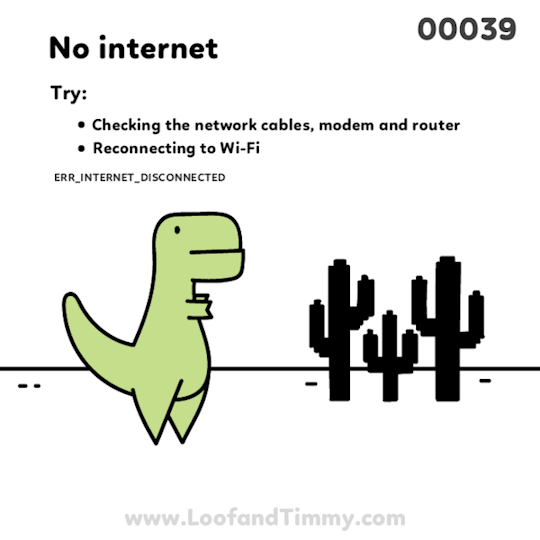
Syria is a country located in southwestern Asia near the east coast of southwestern Asia. The Syria area about Golan Heights was once the territory of Israel in 1967. Its capital, Damascus, is located in the oasis at Mount Qasiyun on the Barada River (Salibi et al. 2020). Syria is one of several countries that have internet restrictions. The Syria telecommunication market is a government monopoly. Even though it controls 55% of the country’s cellular phone market, many small private telecommunication organizations still rely on government support and rules. Syria gives internet access to 20% of its total population with 56kb connection speed through dial-up with less cable dial-up and fiber connection.
Most Syrians use social media to connect with other Syrians, such as spreading information or opinions. Also, to raise awareness about politics inside and outside the country. Moreover, they also use it to create a public sphere, activists, and youth leaders, but only a few Syrian people participate. Although they are given a little freedom to use social media, they must avoid content related to internet regime challenge or human rights because they will get penalties such as accounts getting blocked, people get arrested, and even killed. In addition, Syrian authorities believe that those contents can weaken the national morale.
Syria has blocked around 240 sites which are email services such as Hotmail and Yahoo, along with hosting user-created sites on Facebook, Twitter, YouTube, and others. So, by limiting internet usage to Syrians, authorities believe it will have a more significant efficient effect than the potential costs to arrest activists and block accounts and sites (Tkacheva et al. 2013, pp. 74-81). Nevertheless, Syrians have tried to use VPN to avoid getting penalties for breaking laws. However, it is not adequate for some social media platforms such as Netflix. Moreover, even if Syrians manage to get accessed, they still need an activation code from a text message, and the message cannot be sent to Syria number, which leads to blocking their users unless they have numbers from friends who liveaboard (‘Under international restrictions, Syrian cannot access online platform’ 2021).

I personally think that during the covid 19 Pandemic, the internet has become an essential tool to interact with other people in a long-distance communication so that people will not get contagion and also beneficial for the country not to have spent high treatment for the large number of citizens who get the virus. During this pandemic, Syria allows its citizens to have internet access to more than 3TB from TSF (an international non-government company that focuses on humanitarian crises) to strengthen their mind against COVID-19 because of psychological distress (‘Northeastern Syria: hospitals run out of funds and supplies as second COVID-19 wave hits region’ 2021).
References
‘Northeastern Syria: hospitals run out of funds and supplies as second COVID-19 wave hits region’ 2021, ReliefWeb, 5 May, viewed 18 May 2021, <https://reliefweb.int/report/syrian-arab-republic/northeastern-syria-hospitals-run-out-funds-and-supplies-second-covid-19>.
‘Under international restrictions, Syrian cannot access online platform’ 2021, The Arab Weekly, 19 March, viewed 18 May 2021, <https://thearabweekly.com/under-international-restrictions-syrians-cannot-access-online-platforms>.
Salibi, KS , Irvine, VE , Smith, CG , Hamidé, A-R , Scullard, HH , Hourani, AH , Ochsenwald, WL , Commins, DD , Gadd, CJ & Polk, WR 2020, "Syria", Encyclopedia Britannica, 11 June, viewed 23 May 2021, <https://www.britannica.com/place/Syria>.
Tkacheva, O, Schwartz, LH, Libicki, MC, Taylor, JE, Martini, J & Baxter, C 2013, Internet freedom & political space, RAND Corporation, California.
7 notes
·
View notes
Text
Crutchie and Polio in the 1890s
Something that has bothered me since I joined this fandom is the unfortunate inaccuracy in many depictions of Crutchie having polio. To that end, I have attempted to debunk some common misconceptions about polio in general, and how polio would have affected Crutchie, in this post. (Apologies for how long this is, medical history is one of my niche interests).
To start, let’s talk a little bit about what exactly polio is, and what it does to the body.
Polio, or poliomyelitis (although it was often called infantile paralysis historically) is a disease caused by the poliovirus. The virus spreads from person to person and can cause paralysis, among other complications.
The majority of people who get infected with poliovirus will not have any visible symptoms (about 72 in 100 people with polio have no symptoms). Of the people who do have symptoms, many only have generic flu-like symptoms such as fever, nausea, and head and stomach pain, without paralysis. Only a low percentage of people will develop serious complications, among them the most familiar being paralysis. This means that Crutchie could have been exposed to the poliovirus and have caught it from people who had no idea that they even had the disease.
In terms of symptoms, Crutchie’s polio would have started out with the same symptoms as the flu (fever, headache, nausea, fatigue, sore throat, etc.) He could have also experienced back pain, back stiffness, neck pain, neck stiffness, muscle weakness, and pain or stiffness in the arms and legs. These symptoms could last for up to a week before paralysis would happen.
Symptoms of paralytic polio include a loss of reflexes, severe muscle aches and spasms, muscle weakness, loose and floppy limbs, deformed limbs, and sudden temporary or permanent paralysis. Paralysis can occur anywhere in the body, with varying levels of severity. Polio can also affect the throat and lungs, impairing breathing and making swallowing extremely difficult. However, this likely did not happen in Crutchie’s case, because in an age without the iron lung (invented in 1927) had his breathing been severely impaired by the virus he likely would have died.
Once a person with polio’s fever breaks they are usually no longer contagious through the air, although their stool can remain infected for 3 to 6 weeks after contracting the virus. After this, paralysis can go away on its own, although physical therapy is helpful as well.
Crutchie probably contracted polio well before the strike, given that his leg muscles have atrophied to the point that they have in the show. An outbreak of polio occurred in the United States around 1893, and then again in 1894, which could have been when he caught it, or he could have caught it before then (again, polio is highly contagious but most people don’t show symptoms). Personally, I headcanon that he caught it before 1893 because polio mainly affects children under the age of 5 or 6, but he could have caught it later than that as well.
One thing that I need to note here that I see in fanfiction stories all the time is that paralysis caused by polio is usually not gradual. That is, it usually occurs suddenly, almost overnight, and not slowly over a longer period.
If you headcanon that Crutchie caught polio before becoming a newsie and moving into the lodging house, he was likely treated at home. Hospitals around the turn of the century were often overcrowded and not the most sanitary of places (although that was rapidly changing all over the country). If you headcanon that Crutchie caught polio while living in the lodging house, however, he would’ve been taken to the Hudson Street Hospital as soon as it was discovered that he had polio, and the entire lodging house would have been fumigated (disinfected) to prevent contagion (this happened in 1897 when a newsboy named John Kelly was diagnosed with diphtheria and sent to the hospital, but it later turned out that he only had tonsilitis).
In terms of what kinds of treatments Crutchie would have had access to, the answer is, unfortunately, not much. The primary rehabilitation treatments for polio (known as the Sister Kenny treatments) would not begin to be developed until 1911 when Australian nurse Elizabeth Kenny saw her first case of polio, and they would not catch on in the United States until the 1940s and 50s. The main treatment for polio at the turn of the century were leg and arm braces, intended to “correct” the paralysis, which Crutchie would have had limited access to as a poor, working-class person (and which had limited success without physical therapy anyway). However, Crutchie could have been given exercises to do to strengthen and rehabilitate his muscles by a doctor, such as the stretch we see him and Jack doing during Carrying the Banner, meaning that his paralysis could get better over time. Paralysis caused by polio is also rarely permanent, so Crutchie likely was paralyzed more right after he first caught polio and then gradually regained the use of his limbs over time.
Now, for a word about post-polio syndrome.
Post-polio syndrome (PPS) is the return of certain symptoms of polio years after a person has first had the disease. It can occur anywhere from 15 to 40 years after someone has had polio. About 25 to 50 percent of people who have had polio will develop PPS, so it’s certainly possible that Crutchie could have developed it. In rare cases, it can be fatal, but it is usually not, especially with physical therapy and other management techniques. Symptoms of PPS include muscle and joint weakness, muscle pain, becoming tired more easily, muscle atrophy, trouble breathing or swallowing, sleep apnea, and low tolerance of cold temperatures. It is also important to note that since it is unlikely that Crutchie’s lungs were affected by polio, there is no reason that he should get sick more easily than other people because of his polio (he could still just have a naturally low immune system, however).
I hope this was informative (and not too boring). Please feel free to send me any questions you may still have about this or any other topic!
Sources:
https://www.healthline.com/health/poliomyelitis
https://www.mayoclinic.org/diseases-conditions/polio/symptoms-causes/syc-20376512
https://www.cdc.gov/polio/what-is-polio/index.htm
64 notes
·
View notes
Text
The Stigmatization and Racism of a Disease
The first known cases of AIDS in the United States was reported in June of 1981 (“The HIV/AIDS”), which kick started one of America’s most controversial waves of illness that is still around today. It caused a large and widespread disruption in America, “...despite the virus neither being especially contagious in the conventional sense of contagion… nor even deadly if treated properly with antiviral drugs” (Bronwen and DeCoster). This is because the largest group of people the virus is contracted by is from male-to-male sex (46%), followed by injection drug use (25%) (“HIV and AIDS”). A wave of illness that was mainly killing homosexual men caused attitudes to, “...reflect moral judgements rather than fears of contagion, with people living with HIV/AIDS classified as deviant in the public imagination” (Bronwen and DeCoster) during its initial outbreak in the United States. It is also noted that while in the beginning of the epidemic, the people contracting the virus were mostly white, but was later categorized as a more racist stereotype for black gay men. The cause of which being, while white gays in the 80’s were not particularly welcome in conservative America, they still had their lighter complexion to hide behind… African American and other homosexual men of color did not.
One article described this phenomena by saying that, “The body infected by HIV has also been penetrated by a set of politically and socially hostile notions… These are precisely the notions that have characterized homophobia and white racism in the age of Acquired Immune Deficiency Syndrome (AIDS)” (Epstein). The sickness was almost like a natural affirmation for heterosexual, white America to further discriminate against marginalized groups. It allowed for them to point and say, there, if this is normal, if being gay is normal, then why do they have this deadly illness? The lack of government response or even educational and preventative information broadcasts from the Reagan administration only furthered the homophobia and racism leaking into the medical world.
The blatant discrimination that the afflicted people faced was only highlighted when a famous actor suddenly died from the disease. Straight, white, and popular, his death sparked, “...the fear hidden behind the articulated concern about leakage”, and, “...masked a deeper fear that to contract AIDS is to become homosexualized” (Epstein). A disease should not be politicised, and yet, because of who it primarily affects, it was taken less seriously and harmed communities that were already suffering from other socio-economic issues. It was feared among the masses, but there was no centralized push to take care of its victims. Homophobia that was caused from America’s deep rooted “Judeo-Christian morals”, and cultural and institutionalized racial discrimination from the Jim Crow Era were the roots of the stigmatization of the 80s AIDS crisis. Again, while well-off, white Americans had nothing to gain by letting their fellow citizens die from a treatable disease, they also had the idea that they weren’t particularly losing any “moral” citizens to AIDS. This greater sentiment towards the disease, and more specifically towards those who frequently contracted and suffered from it, perpetuated the homophobia and racism that was built into America by the inaction of the government and the stigma of its majority population. Nothing was being done to keep the American people safe, simply because of the societal contempt towards the affected groups, namely blacks, addicts, and gays.
Works Cited
EPSTEIN, JULIA. “AIDS, Stigma, and Narratives of Containment.” American Imago, vol. 49, no. 3, 1992, pp. 293–310. JSTOR, www.jstor.org/stable/26304009. Accessed 10 Dec. 2020.
HIV and AIDS --- United States, 1981--2000. Centers for Disease Control and Prevention, Centers for Disease Control and Prevention, 2001, www.cdc.gov/mmwr/preview/mmwrhtml/mm5021a2.htm.
Lichtenstein, Bronwen, and Jamie DeCoster. “Lessons on Stigma: Teaching about HIV/AIDS.” Teaching Sociology, vol. 42, no. 2, 2014, pp. 140–150. JSTOR, www.jstor.org/stable/43187474. Accessed 10 Dec. 2020.
The HIV/AIDS Epidemic in the United States: The Basics, 25 Mar. 2019, www.kff.org/hivaids/fact-sheet/the-hivaids-epidemic-in-the-united-states-the-basics/.
1 note
·
View note
Text
TAFAKKUR: Part 95
The Revival of Prophetic And Herbal Medicine: Part 1
Introduction
The example of Prophet Muhammad, upon him be peace, is explicitly commended in the Qur’an as the best pattern for believers to follow. Therefore, the practice and precepts of the Prophet have been a source of legal judgements and general guidance in the affairs of Muslims since the earliest days of Islam, a source which supplements and is second only to the Qur’an. Since health is so important a part of human well-being, it is not surprising that Muslims over the centuries devoted so much effort to recording and reflecting upon what the Prophet taught about maintaining good health, preventing and curing diseases and ailments.
The most widespread book on ‘Prophetic Medicine’ was that written by Ibn Qayim al-Jawziyiah (691-751AH / 1293-1351). But there are scores of manuscripts on the subject in world libraries and museums. After a preliminary study, I found references to some forty different books (some published, most manuscripts, some lost) with the title ‘Prophetic Medicine’. In his 1985 paper on Islamic heritage, S. Abdullah al-Habashi of Yemen mentioned 23 monographs by different authors on plagues and infectious diseases - I could add a further 16 on the same subject. He went on to write a book on infectious diseases as related to Prophetic Medicine, with a Foreword by the late Sheikh al-Azhar. ‘Abd al-Halim Mahmud.
Recently, the number of publications on Prophetic Medicine as a whole or on different areas of it has been growing rapidly. There are many books and articles, referenced with ahadith (sayings) of the Prophet on the curative properties of honey, black seed (Nigella Sativa), senna (Casiacutifolia), henna (Lawsonia Inermis), aloes (Aloe Vera), garlic and onions, olive oil, etc.; on the positive health benefits of breast feeding, and of the Islamic practices of fasting, prayers, ablution, cleaning the teeth and mouth, etc. Doctors in particular have been very active in elucidating the relevant ahadith and their importance to health promotion and disease prevention. Papers are published almost weekly on Islamic teachings related to health concerns, for example on food and drink (prohibition of excess, of pork, blood, and intoxicant drugs like alcohol), on circumcision, on sexuality and marriage (particularly with regard to the spread of sexually transmitted diseases such as AIDS).
There is growing interest, too, reflected in the volume of publications, in spiritual medicine which treats psychological ailments believed to be produced by evil jinn (evil spirits). Die treatment usually includes reciting particular chapters or verses of the Qur’an, certain supplications attributed to the Prophet, and making incantations.
Current issues in medical ethics from an Islamic perspective have also received a great deal of attention in recent times. There are literally hundreds of articles, books and doctoral dissertations on organ transplantation, brain death, new methods of procreation including test-tube babies and surrogacy, abortion, contraception, cloning and genetic engineering.
Traditional Medicine
As lbn KHaldun observes in his famous Muqaddimah, the pre - Islamic Arabs used a sort of folk medicine based on herbs and plants tested by experience and handed down. At the time of Prophet Muhammad, there were surgeons adept at treating wounds, abscesses and other minor operations, and also some renowned physicians like al-Harith ibn Kalada of Ta’if who had travelled to Jundishapur (near Ahwaz in Iran) to gain more knowledge. The Prophet asked his cousin Sa’d ibn Abi Waqqas to consult al-Harith when Sa’d fell ill after the conquest of Makkah in 8AH(630).
Cupping, venesection and cautery were all common pre-Islamic treatments endorsed by the Prophet with some reservation against cautery. Cupping with blood-letting was definitely encouraged by him and there are tens of ahadith related to this procedure. It is interesting to note that cupping and cautery are still widely practised in Arab countries, especially among villagers and Bedouins.
Recently, Dr. Mansoor Suliman of the medicine faculty of King Abdul Aziz University, Jeddah, published a paper on ‘The myth and reality of treatment by cautery’ in Alternative Medicine (1986, 1(3), pp.237-40). He studied 500 patients treated with cautery and modern techniques for different ailments. He found that cautery was useful in treating diarrhoe where 45% of those cauterized showed marked improvement. Cautery was useless for jaundice, haemolytie blood diseases, respiratory diseases, other infectious diseases and cancers, though it was helpful in stopping bleeding. Diathermy (cautery) is also used in modern medicine to treat epistaxis, cervical erosion, to stop bleeding during operations, and to remove warts and other skin tumours. There are also different types of modern heat therapy e.g. infrared and laser therapy.
Cupping and blood-letting were used widely in the past to treat different ailments e.g. hypertension, polycythemia, and even heart failure. Modern medicine rarely, if ever, resorts to such measures.
The pre-Islamic Arabs believed in supernatural forces such as evil spirits, the evil eye and so on, and sought to counter them with spells, amulets, talismans and other animistic practices. The Qur’an (see 72.6) deplored all such rituals of seeking refuge from evil spirits as a pseudo-worship and therefore a sort of polytheism. The Prophet Muhammad scorned superstitious beliefs. Al-Bukhari records his saying: ‘There is no Adwa (i.e. contagion) [except by the will of Allah]; no Safar [the pagan Arabs believed that Safar, the last month in the lunar calendar, can cause malady. Safar could also refer to huge ‘snakes’ that dwell in the abdomen of some people and cause serious disease]; no Ha’ma [i. e, vengeful ghosts of the dead that hover around the living].’ And Tirmidhi records the Prophet saying: ‘Whoever wears an amulet has relapsed into shirk (polytheism). Whoever goes to a fortuneteller or a divine and asks him about anything, his prayers extending for four nights will not be accepted.’ In another hadith, he said: ‘Magic spells, amulets and the like are shirk.’ Polytheism is considered in Islam the worst of sins, the one that will never be pardoned by God until the person repudiates all forms of polytheism and reverts to pure, original monotheism. The Muslim should have faith in God alone, in whose control lie the causes of health and disease, life and death, in fact of all things, small or large.
#allah#god#muhammad#prophet#sunnah#hadith#quran#ayah#islam#muslim#muslimah#hijab#help#revert#convert#religion#reminder#dua#salah#pray#prayer#welcome to islam#how to convert to islam#new muslim#new revert#new convert#revert help#convert help#islam help#muslim help
1 note
·
View note
Text
https://www.psychologytoday.com/us/blog/social-empathy/202005/can-we-have-too-much-empathy
omg omg
During these difficult times there is so much grief and loss that our feelings for others can go into overdrive. That is not empathy. When we are consumed by emotions, even if a reflection of another person’s feelings, we are experiencing emotional contagion. This is our ability to mirror or imitate the sensations of others, but doing so without using the rest of the skills behind empathy.3 Being fully engaged in empathy includes skills that allow us to separate our feelings from those of others.
Footnote 3 cites:
3. Singer, T., & Decety, J. (2011). Social neuroscience of empathy. In J. Decety & J. T. Cacioppo (Eds.), The Oxford handbook of social neuroscience, pp. 551–564. New York: Oxford University Press.
...I must see if I can get a hold of this study.
3 notes
·
View notes
Text
What Chris Hedges fails to understand about black bloc activity is that it arises from a real need. The “cancer” that Chris finds so disturbing—the contagion of an anonymous collective force—is precisely why and how it continues to outlive every social movement from which it emerges. These generations—we who fantasized about Columbine and now only know metal detectors at school; we who expected September 11 and now only know the politics of terror; we who grew up as the world crumbled all around us and now only know the desert—we need to fight, and not just in the ways our rulers deem justified and legitimate. As workers, we’re excluded from unions, from collective arrangements of any kind. When we manage to find employment at all, it is meaningless labor that corresponds to our own superfluousness in the economy. We were raised by a generation so thoroughly defeated that it feared to pass on its history. We are the inheritors of every unpaid bill, of every failed struggle, the products of the insanely selfish individualism of advanced capitalism in North America.
Our entire environment feels hostile. Hence our hostility.
Chris Hedges cannot understand this because he misses the real historical conflict expressed in contemporary struggles. […] The black bloc spreads because of a real need to take back force, which has been monopolized by the police. The black bloc spreads because it is a living practice of collective intelligence, redistribution of wealth, and improvisation; it spreads because it interrupts the ways we are confined in our identities as subjects within capitalism. The black bloc is tuned to the uneasy pulse of our time.
God Only Knows What Devils We Are: An Apologia for the Black Bloc from the Community of Those Who Have No Community (Institute for Experimental Freedom, c. 2012), pp. 16–17.
3 notes
·
View notes
Link
This is a preview of the Storytelling chapter from the upcoming Contagion Chronicle. The Kickstarter only has about two days remaining: if you’ve been curious about it, now��s your chance to join the infected!
The Contagion Chronicle is, by default, a crossover game. You can use anything in this book in other games, likeWerewolf or Geist, but it’s designed to enable chronicles in which the characters come from multiple game lines.
This chapter provides the Storyteller with advice on how to run the Contagion Chronicleitself, and how to run Chronicles of Darkness crossover games in general.
Running the Contagion Chronicle
This book is a game of what if: what if everything the characters trusted turned on them, and everything they took for granted flipped upside down? It’s a journey into Wonderland, if Wonderland looked like their shitty studio apartment and their clunker with the blacked-out windows, but felt like the rules they understood no longer applied and everything was what it wasn’t. Taking charge of the situation means opening themselves up to ruin and potentially letting the madness run rampant, through them and everything they love. So running this game means balancing the risk of losing everything and the threat of Armageddon with playability and ensuring the players and their characters retain agency.
Theme and Mood
The Contagion is about loss of control — control of yourself, others, your environment, and your circumstances. Imagine a dementia patient, terrified to realize he no longer remembers his own family or what year it is. He can’t function on his own anymore, and things seem to happen at random. His actions prompt the wrong reactions. People tell him the facts he knows to be true are false, and he has no way of knowing whether they’re right or just lying to take advantage of his confusion. That’s the Contagion.
Unlocking this chronicle’s core themes in play can be tricky, because you want the characters to experience loss and disorientation without letting those experiences spill over onto the players. Open communication and transparency are crucial. You can use musical cues, Clues from the investigation system on Chronicles of Darkness p. 77, and clear pathological language to alert the players that something that seems nonsensical is actually part of the Contagion, and thus they can study and fight it.
Although this book talks about “the Contagion” and “infection” like it’s a disease with observable symptoms, characters won’t know it’s a sickness until they investigate and start to understand the bigger picture. Show them what’s happening, rather than telling them. Don’t say, “this Infrastructure is infected.” Instead, describe the ripple effects and let them come to the conclusion that it’s the Contagion on their own as they dig deeper.
Loss, Change, and Chaos
Go ahead and break things — you have permission. Break smaller things on the local and personal level at tier 1, larger things across whole regions at tier 2, and fundamental things across the world at tier 3. Stop the sun from rising in the morning or setting at night. Let the Faerie lord show mercy for no good reason, and a trusted companion act like a hated enemy with no obvious explanation. Give the characters’ powers unexpected side effects and replace their beloved traditions with nonsense. To raise the stakes, pull the trigger on Chekov’s Contagion. If an outbreak that weakens the Gauntlet doesn’t result in running across a place where it crumbles entirely and the material world merges with Shadow, the players will have trouble taking the threat seriously. Make them fear what happens if they do nothing by showing it to them; it keeps them actively engaged.
Always know exactly what you’re breaking and how, and what else shatters when you do it. Don’t break random things, because then the characters have no hope of unraveling the mystery. Jot down notes on the ripples your changes make. Think about the logical conclusion to a situation in which something important changes, and don’t be afraid to go big. That said, make sure whatever you change affects the characters in some personal way, even in a tier 3 game. Monsters stepping out of portals from another realm all over the world doesn’t matter to your game unless one of those monsters steps into a crowded square and takes a bite out of the players’ favorite ally. Also, make sure you don’t break things until the characters and the players are fully invested in what they have to lose; you have to show them what their normal is before you take it away.
Paranoia and Trust
Very little is sacred when the Contagion gets involved, but that goes for characters, not for players. Characters should doubt their knowledge and senses, but players need to be able to trust you. The group builds the story together; you may control the characters’ enemies, but you yourself are not an enemy. So how do you create a paranoid mood without making players feel anxious themselves?
First, communicate with your players. Make sure they know up front what sort of chronicle they’re getting into if your whole game is the Contagion Chronicle. If you introduce it later, talk to them after the first chapter in which Contagion symptoms appear, and explain that while things are getting strange, you’re not just arbitrarily changing the rules — they have the power to investigate and oppose the madness. Try to introduce the Sworn (and/or the False) in the same chapter, although the players may not learn yet what that means, so they know options exist and a plan is in motion even if they can’t see its shape.
The characters are special: they, the Sworn and the False, are the only ones who can see reality’s sickness. Even others of their own kind act like these nonsense syndromes are the way things have always been, making the protagonists question themselves. Stress this to make the characters feel alone and vulnerable, while the players feel empowered as the only ones who can save the world.
One simple way to close the gap between character paranoia and player trust is with the investigation system. Players feel better about in-game confusion and desperation if they know dice can help them actively progress. An investigation lets them do that and puts some of the power of resolution in their hands. Giving players a participatory role in the narrative through codified rules means giving them agency and helps them feel excited instead of wary about the inexplicable bullshit their characters go through. You can also use the optional conflict resolution system in this chapter, on p. XX.
While characters should experience loss, don’t take away things the players spent Experiences or significant effort to access too often, unless the characters sacrifice them on purpose. That doesn’t mean the Contagion can’t screw around with those things — in fact, it should, because that’s a simple way to make the stakes feel high. Nothing incites a player to action faster than the threat of losing something she earned. Actually remove those things altogether only sparingly, though, unless it’s just for a scene or so. For one thing, players get resentful when you take away things they worked for without their consent. For another, it’s almost always more interesting to make things weirder than to negate them entirely. If the Contagion has an effect on certain kinds of magical powers, it’s better to give them dreaded side effects, make them interact strangely with other phenomena, alter their parameters, have them activate uncontrollably, or fail under specific circumstances. This creates story hooks, while saying such powers just don’t work tends to take story hooks away.
If a character does permanently lose something to the Contagion on which the player spent Experience points, give the Experience points back and let her spend them on something else relevant to the current story; this practice already exists in the Sanctity of Merits rule (Chronicles of Darkness pp. 43-44), but since the Contagion can theoretically mess with innate abilities, apply it across the board.
Anytime a character temporarily loses access to something important or the Contagion affects her in a way that puts her in harm’s way or imposes a significant setback, award the player a Beat or inflict a Condition (which provides a Beat when it resolves). Beats are how the system incentivizes players to accept or create narrative twists that get their characters in trouble and up the stakes, so the Contagion’s effects should always provide Beats whenever they cash in on the threatened horror of loss and paranoia. If this happens in direct service to acting against the Contagion or supporting the Sworn, make them Sworn Beats.
Don’t let the Contagion mess with Vector powers, though, because the Sworn specifically developed them as a reaction to the Contagion in the first place.
4 notes
·
View notes
Text
Automotive Load Floor Market : Value Chain, Stakeholder Analysis and Trends by 2030
Sustainability-centered initiatives surrounding innovation and the need for development of alternative sources of propulsion in the automotive industry have put pressure on the capital performance of automotive load floor market over the recent past. Raw materials such as polypropylene (PP) and composites help reduce the overall weight of automobiles by almost a third, keeping rigidity and durability intact, and this potential makes them a top priority for market players.
Request a Sample of this Report @ https://www.futuremarketinsights.com/reports/sample/rep-gb-7658
Automotive Load Floor Market Outlook & Key Findings
The automotive load floor market is projected to grow at 4.5% CAGR over the forecast period (2020-2030)
Composites to remain material of choice among manufacturers
Compact vehicle segment will witness highest adoption of automotive load floors
Load floor systems are expected to capture leading revenue share, tantamount to 44% of automotive load floor market value
East Asia continues to offer opportunities of growth and profitability, owing to presence of automobile manufacturing hubs
Evolving market dynamics and stiffening competition are compelling automotive load floor manufacturers to turn to patented technologies. As such experiments gather pace, end users expect a greater of performance and customization. So, market players must create distinctive strategies to integrate technology into their operations to capture the value at stake.
Future Market Insights, in its latest report, projects that the global market for automotive load floors is poised to register revenues worth of US$ 3.2 Bn by 2030.
Key Takeaways of Automotive Load Floor Market
Polyurethane (PU) or polypropylene (PP) based honeycomb technology to reduce overall vehicle weight by 20-30%
Fixed automotive load floors will remain most worthwhile and are expected to procure around 77% of the market revenue through 2030
Stringent emission norms across the globe to propel adoption of automotive load floors
Market in South Asia & Pacific to experience meteoric growth over the following decade
Booming uptake of electric vehicles (EV) to offer potential growth avenues in near term
Download PDF Brochure @ https://www.futuremarketinsights.com/reports/brochure/rep-gb-7658
COVID-19 Impact on Automotive Load Floor Market
The global automotive load floor market continues to face the brunt of the coronavirus (COVID-19) pandemic as sales of vehicles have slumped due to factory closures, collapse in demand, and supply chain disturbances. As market players enter into the latter half of 2020, there are some varying signs of recovery visible, as well as of further disruptions ahead.
Uncertainties prevail, with epidemiological numbers soaring in various countries of South America and Asia, and, most worrying, in the US. Even though China was showing positive signs of a probable V-shaped rebound, June sales dipped considerable, implying a see-saw battle ahead. The US industry also, despite coming up with some favorable figures in May, waned last month.
With risks of further virus contagion and preventative lockdowns remaining high over the rest of the year, the global automotive load floor market will remain exposed to economic uncertainties.
Key Segment
By Material Type
Hardboard
Fluted Polypropylene
Honeycomb Polyprolene
Composites
By Operation
Fixed
Sliding
By Application
Interior Systems
Cargo Systems
Load Floor Systems
By Vehicle Type
Compact
Mid-Size
Luxury
SUV
LCV
Mini-Bus
Van
By Region
North America
Latin America
Europe
South Asia & Pacific
East Asia
Middle East & Africa
Pre-Book Report @ https://www.futuremarketinsights.com/checkout/7658
Automotive Load Floor Market – Competitive Intelligence
The global automotive load floor market is characterized by presence several domestic and international players, thus, making the market landscape highly fragmented. Leading manufacturers such as DS Smith, Huntsman International LLC, and Nagase America Corporation capture about 20-25% of the overall market value. Organic and inorganic strategies including, mergers & acquisitions (M&A), are likely to govern growth tactics market players.
Top Reports Related To Automotive Market Insights
Automotive Pump Market : The automotive pump market is expected to witness a significant growth in 2021, thanks to the implementation of various carbon emission norms across various countries. A study by Future Market Insights (FMI) on automotive pump market has forecast it to reach US$ 106.0 Mn by the end of 2031, growing at a CAGR of 6.1% over the forecast years (2021-2031).
Aircraft Cabin Interior Market : According to Future Market Insight’s (FMI), the global aircraft cabin interior market is forecast to grow at 2.70% in 2021, overcoming the uncertainty about market recovery and performance during a global pandemic. FMI also predicts that the aircraft cabin interior market will exceed the overall market valuation of US$ 14.5 Bn by the end of 2021.
About FMI
Future Market Insights (FMI) is a leading provider of market intelligence and consulting services, serving clients in over 150 countries. FMI is headquartered in Dubai, the global financial capital, and has delivery centers in the U.S. and India. FMI’s latest market research reports and industry analysis help businesses navigate challenges and make critical decisions with confidence and clarity amidst breakneck competition. Our customized and syndicated market research reports deliver actionable insights that drive sustainable growth. A team of expert-led analysts at FMI continuously tracks emerging trends and events in a broad range of industries to ensure that our clients prepare for the evolving needs of their consumers.
Contact
Mr. Debashish Roy Unit No: AU-01-H Gold Tower (AU), Plot No: JLT-PH1-I3A, Jumeirah Lakes Towers, Dubai, United Arab Emirates MARKET ACCESS DMCC Initiative For Sales Enquiries: [email protected] For Media Enquiries: [email protected] Website: https://www.futuremarketinsights.com Report: https://www.futuremarketinsights.com/reports/Automotive-Load-Floors-Market Press Release Source: https://www.futuremarketinsights.com/press-release/Automotive-Load-Floors-Market
0 notes
Text
Pastoral, Anti-Pastoral and Necro-Pastoral
PASTORAL, ANTI-PASTORAL AND NECRO-PASTORAL
AGRICULTURAL CRISIS AND THE PASTORAL TRADITION
- Focusing on the literary construction of nature and surrounding agriculture
- Oil to Soil
- Problematic relationship with place and mechanises relationships with rural landscapes
- Transforming nature (GM foods/crops) Seed stocks, global capital control of seed types.
Terry Gifford, ‘Pastoral, Anti-Pastoral and Post-Pastoral as Reading Strategies’
‘the ancient pastoral impulse of retreat to a rural landscape and return to the city’ (p. 13) a pastoral retreat, common to many novels of escape from the city (European) retreat and renewal for health.
· It is a space that is not for work or labour but for leisure and it is restorative
· WB Yeats poem ‘The Lake Isle of Innisfree’: ‘I will arise and go now, and go to Innisfree […]’
· Cityscape is a threatened space which is constricted and then the countryside is free and safe. Think of The Lion the Witch and the Wardrobe.
· Peace and pure space, a pristine but cultivated space, ‘Nine bean0rows will I have there, a hive for the honey-bee’ [Yeats].
· Sense of harmonious lifestyle
· Pastoral has a sense of loss especially in poetry—a poetic elegy. Fears of encroaching industrialisation and the poem is a sense of preservation of the purity of pastoral and landscape.
· The pastoral ‘implies an idealisation of rural life that obscures the realities of labour and hardship’ (Garrad, 2011, p.38)
· ‘Peasant life becomes pleasant life’
Anti-Pastoral texts that exhibit:
- Corrective of pastoral, often explicitly
- Unidealised, harsh and unattractive
- The hardship of rural life
- Challenges literary constructs as false distortions
- Emphasises ‘realism’
- Inequality and class division in pastoral writing
- Nature is not always welcoming and harmonious (mainly due to human interference)
- Cormac McCarthy’s, The Road – violent and harsh landscapes of the novel ‘can act as a warning about the very future of nature itself, upon which we all depend’ (2012, p.19-20).
Post Pastoral
- Wordsworth sublime and awe in nature at huge natural forms, however, it is not about the human reaction it rethinks our position in relation to nature. Respect.
- Recognising the human capability and responsibility
- Nature’s own creative-destructive nature such as life, birth, death and recognising that we are a part of cycles and our actions have consequences
- If our inner nature echoes outer nature, how can the outer help us understand the former? Romanticising nature and engaging the inner-self with the natural world.
- If nature is culture, is culture nature? In NZ there are some rivers that are classed as humans and any violation applied to the river is the same to humans. Pollution means GBH.
- Arcadia and English culture
- How can consciousness, through conscience, help us heal Morality and ethics https://natureornature.tumblr.com/post/169300236213/uplifting-poetry alienation of home, possessive of nature as ‘our home’ when reality nature owns us.
Necro-Pastoral
- ‘It does not subscribe to humanism but is interested in non-human modalities, like those of bugs, viruses, weeds and mould’ (McSweeney, 2014). Focuses on the part of nature that we may ‘turn our snout’ up too. Political aesthetic zone, dark aesthetics of bugs and the comparison to the politics of such ideas.
- Sublime, both beautiful yet horrifying as it is overwhelming or in awe.
- Green Fantasy vs Dark Reality
- Strange Meetings in the Necropastoral: Owen, Hawkey, Césaire (pp. 3-20)
‘I give the name “necropastoral” to the manifestation of the infectiousness, anxiety, and contagion occultly present in the hygienic borders of the classical pastoral. For all the pastoral’s shoring up of separations, and despite the cordon sanitaire it purports to erect between unhealthy urban strife and wholesome rural peace, we must remember that the premier celebrity resident of Arcadia is Death. It is into the rural that rich urbanites flee with their plague, and into the “urbs” that rat-vessels steer with their cargoes of fleas. ‘
- ‘Tea-Strainer’ by Joyelle McSweeney
- ‘Florida’ Elizabeth Bishop
8 notes
·
View notes
Photo

THE CONSECRATIONS OF PORTUGAL (1931, 1938) AND THEIR BENEFITS
When the Pope, along with all of the worlds bishops, consecrates Russia to the Immaculate Heart of Mary, what will we see? What will the Triumph of the Immaculate Heart of Mary look like? Many people are not aware that Our Lady already gave the world a glimpse, a prelude, of what the Triumph of Her Immaculate Heart will be like. She did this in Portugal after the Portuguese bishops consecrated that nation by name to the Immaculate Heart, on May 13, 1931.
It seems that Our Lady used Portugal to demonstrate on a national level what She will do worldwide when the Pope, in union with the worlds bishops, consecrates Russia to Her Immaculate Heart. Perhaps Our Lady also gave us this preview so that an insipid pan-religious "civilization of love" could never masquerade successfully as the Triumph of Heavens Queen.
THE CONSECRATION OF PORTUGAL (1931)
On May 13, 1931, in the presence of the 300,000 faithful who had come to Fatima for the event, the bishops of Portugal solemnly consecrated their nation to the Immaculate Heart of Mary. These good bishops placed Portugal under the protection of Our Lady to preserve that nation from the Communist contagion that was sweeping through Europe, and especially Spain. As a result of this Consecration, Portugal experienced a three-fold miracle. Here, we will outline this miracle.
1) There was a magnificent Catholic Renaissance, a great rebirth of Catholic life, so striking that those who lived through it attributed it unquestionably to the work of God. During this period, Portugal enjoyed a drastic upsurge in priestly vocations. The number of religious almost quadrupled in 10 years. Religious communities arose likewise. There was a vast renewal of Christian life, which showed itself in many areas, including the development of a Catholic press, Catholic radio, pilgrimages, spiritual retreats, and a robust movement of Catholic Action that was integrated into the framework of diocesan and parish life.
This Catholic Renaissance was of such a magnitude that in 1942 the bishops of Portugal declared in a collective Pastoral Letter: "Anybody who would have closed his eyes twenty-five years ago and opened them now would no longer recognize Portugal, so vast is the transformation worked by the modest and invisible factor of the apparition of the Blessed Virgin at Fatima. Really, Our Lady wishes to save Portugal." (1)
2) There was a miracle of political and social reform, in accordance with Catholic social principles. Shortly after the 1931 Consecration, a Catholic leader in Portugal ascended to power, Antonio Salazar, who inaugurated a Catholic, counter-revolutionary program. He strove to create, as much as possible, a Catholic social order wherein the laws of government and social institutions harmonize with the law of Christ, His Gospel and His Church. (2) A fierce adversary of socialism and liberalism, he was opposed to "everything which diminishes or dissolves the family." (3)
President Salazar did not simply talk a good line: he enacted legislation to protect the family, including laws that frowned upon divorce. One such law read, "In harmony with the essential properties of Catholic marriages: It is understood that by the very fact of the celebration of a canonical marriage, the spouses renounce the legal right to ask for a divorce." (4) The effect of this law was that Catholic marriages did not diminish in number, but increased, so that by 1960, nearly 91 percent of all marriages in the country were canonical marriages.
That is a civilization of love, and it is nowhere in sight as we progress into the Third Millennium.
3) There was the twofold miracle of peace as a result of the Consecration. Portugal was preserved from the Communist terror, especially from the Spanish Civil War, which was raging next door. Portugal was also preserved from the devastation's of World War II.
THE CONSECRATION OF PORTUGAL (1938)
Regarding the Spanish Civil War, the Portuguese bishops had vowed in 1936 that if Our Lady protected Portugal from the Communists, they would express their gratitude by renewing the National Consecration to the Immaculate Heart of Mary. True to their word, on May 13, 1938, they renewed the Consecration of Portugal to the Immaculate Heart in thanksgiving for Our Lady's protection. Cardinal Cerejeira acknowledged publicly:
"Since Our Lady of Fatima appeared in 1917 ... A special blessing of God has descended upon the land of Portugal ... especially if we review the two years which have gone since our vow, one cannot fail to recognize that the invisible hand of God has protected Portugal, sparing it the scourge of war and the leprosy of atheistic communism."
Even Pope Pius XII expressed astonishment that Portugal was spared the horrors of the Spanish Civil War and the Communist menace. In an address to the Portuguese people, the Pope spoke of "the Red Peril, so menacing and so close to you, and yet avoided in such an unexpected manner." (5)
The Portuguese passed this first danger unscathed, but immediately there was a second staring them in the face. World War II was about to break out.
On February 6, 1938, seven months before the declaration of war, Sister Lucy wrote to her bishop, Msgr. da Silva. She told him that war was imminent, but then spoke of a miraculous promise. She said "in this horrible war, Portugal would be spared because of the national consecration to the Immaculate Heart of Mary made by the bishops." (6)
And Portugal was spared the horrors of war, the details of which are too numerous to here recount. (7) Even more remarkable, Sister Lucy wrote to Pope Pius XII on December 2, 1940, to tell him that Portugal was receiving special protection during the war that other nations would have received if the bishops would have consecrated their nations to the Immaculate Heart of Mary. She wrote:
Most Holy Father, Our Lord promises a special protection to our country in this war, due to the consecration of the nation, by the Portuguese prelates, to the Immaculate Heart of Mary; as proof of the graces that would have been granted to other nations, had they also consecrated themselves to Her. (8)
Likewise, Portugal's Cardinal Cerejeira did not hesitate to attribute to Our Lady of Fatima the great graces that had been obtained for Portugal during this time. On May 13, 1942 he said,
"To express what has been going on here for twenty-five years, the Portuguese vocabulary has but one word: miracle. Yes, we are firmly convinced that we owe the wonderful transformation of Portugal to the protection of the Most Holy Virgin." (9)
Cardinal Cerejeira further explained that the miraculous blessings that Our Lady obtained for Portugal due to the 1931 Consecration were a preview of what She will do for the entire world after Russia is properly consecrated to Her Immaculate Heart. The Cardinal said: "What has taken place in Portugal proclaims the miracle. And it foreshadows what the Immaculate Heart of Mary has prepared for the world." (10)
Thus, it is not difficult to understand why the Portugal of this time period has been called the "Showcase of Our Lady". And this triple miracle of Portugal stands as a preview of how Russia and the world will look after the Collegial Consecration of Russia.
NOTES:
1. Collective Pastoral Letter for the Jubilee of the Apparitions in 1942, Merv. XX’s, p. 338. Cited from The Whole Truth About Fatima, Vol. II: The Secret and the Church, FrPre Michel de la Sainte Trinité (English edition, Immaculate Heart Publications, Buffalo, NY, 1989) p. 410.
2. Salazar’s influence in the Portuguese government had been growing since 1928. He became President of the Council in 1933. Later, Salazar received for his efforts the praise and blessing of Pope Pius XII. Pius said, "I bless him with all my heart, and I cherish the most ardent desire that he be able to complete successfully his work of national restoration, both spiritual and material." Cited from The Whole Truth About Fatima, Vol. II, p. 412.
3. Ibid., p. 415. (Salazar’s own words).
4. Ibid., p. 421.
5. Ibid., p. 422.
6. Ibid., pp. 427-428.
7. See The Whole Truth About Fatima, Vol. II, pp. 369-439.
8. Ibid., p. 428.
9. Ibid., p. 405. Cardinal Cerejeira spoke these words during the 1942 Jubilee celebration of the Fatima apparitions.
10. Cardinal Cerejeira, Preface to Jacinta (1942), Obras Pastorais, Vol. II, p. 333. Cf. Also his homily of May 13, 1942, Merv. XX’s, p. 339. Cited from The Whole Truth About Fatima, Vol. II,p. 437.
1 note
·
View note
Photo
Wait, I wrote a paper about this! “Empathy” is a term which means so many different things that Batson (2009) identified 8 different empathies:
Cognitive Empathy (aka Theory of Mind, or ToM) is understanding someone else’s thoughts and feelings.
Motor Mimicry is mimicking someone else’s facial expression, posture, or brain activity.
Affective Empathy (aka Emotional Empathy or Emotional Contagion) is feeling what someone else feels.
Aesthetic Empathy is projecting oneself into someone else’s situation.
Perspective-Taking is imagining how someone else is thinking and/or feeling,
Role-Taking is imagining how one would think and/or feel in someone else’s place,
Empathic Distress is feeling distress because of someone else’s suffering.
Sympathy (aka Empathic Concern) is feeling other-oriented congruent concern for another’s wellbeing — that is, having a feeling about someone else which is as pleasant or unpleasant as their perceived wellbeing.
It sounds like everyone in this thread defined “empathy” as #3, and then split #8 into “compassion” and “sympathy” based on the pleasantness of the feeling — except @quantum-jump’s dad, who defined “sympathy” as #1.
Y’all’s point that sympathy/compassion are morally more important than (affective) empathy is spot on in the moral psychology literature I have read. Sympathy and cognitive empathy are far stronger predictors than affective empathy of helping others instead of harming others (Decety & Yoder, 2015; Eisenberg, Eggum, & Giunta, 2010; Jolliffe & Farrington, 2004). That is why several authors who criticized empathy said that sympathy/compassion “should replace emotional empathy as moral motivation” (Bloom, 2017, p. 25) since, unlike affective empathy, it “is not held hostage to similarity and proximity” (Prinz, 2011, p. 230).
References
Batson, C. D. (2009). These things called empathy: Eight related but distinct phenomena. In J. J. Decety & W. Ickes (Eds.), The social neuroscience of empathy (pp. 3-15). MIT Press. doi:10.7551/mitpress/9780262012973.003.0002
Bloom, P. (2017). Empathy and its discontents. Trends in Cognitive Sciences, 21(1), 24-31. doi:10.1016/j.tics.2016.11.004
Decety, J., & Yoder, K. J. (2016). Empathy and motivation for justice: Cognitive empathy and concern, but not emotional empathy, predict sensitivity to injustice for others. Social Neuroscience, 11(1), 1-14. doi:10.1080/17470919.2015.1029593
Eisenberg, N., Eggum, N. D., & Di Giunta, L. (2010). Empathy‐related responding: Associations with prosocial behavior, aggression, and intergroup relations. Social Issues and Policy Review, 4(1), 143-180. doi:10.1111/j.1751-2409.2010.01020.x
Jolliffe, D., & Farrington, D. P. (2004). Empathy and offending: A systematic review and meta-analysis. Aggression and Violent Behavior, 9(5), 441-476. doi:10.1016/j.avb.2003.03.001
Prinz, J. (2011). Against empathy. The Southern Journal of Philosophy, 49, 214-233. doi:10.1111/j.2041-6962.2011.00069.x
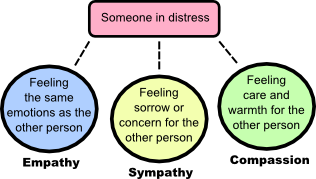
406K notes
·
View notes
Text
Research
Ways to save the ecosystem.
Aspects of ecology themes:
waste
Energy
Natural land
General sustainability
Out of the 4 aspects, my research will go through WASTE. I will be researching the increase of litter, emphasizing on disposable masks in the UK during the Covid-19 pandemic and its impact on the ecosystem.
I will also research the migration and behavior of wild animals throughout the world during the Covid19 pandemic and why they did so.
TIME PERIOD:
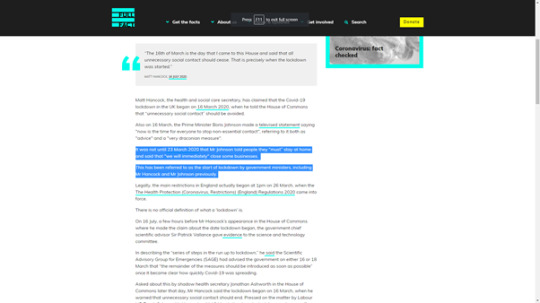
https://fullfact.org/health/coronavirus-lockdown-hancock-claim/
On 16th March 2020, the UK went into its first lockdown. Boris Johnson announced an immediate close in businesses and for people to “stay at home”.

https://www.bbc.co.uk/news/uk-53152416
From the 4th July, the UK’s lockdown restrictions were relaxed, allowing pubs, hotels and restaurants and others to be opened for business along. Where two or more households were able to meet outdoors.
WILD ANIMAL BEHAVIOUR DURING THE PANDEMIC:
While the rest of the world shut in at home due to the coronavirus lockdown, animals however, have come out and claim the unused territory – from man eating big cats in capital cities to monkeys in car parks.
This phenomenon was first noticed when Twitter went viral about swans returning to Venice’s clear canals, but as it turned out those swans were from photographed from Burano in the Venetian Lagoon where swans regularly appear, not Venice. Soon enough images and reports emerged from the corners of the world of a boom in wildlife that this phenomenon was actually happening in small towns and big cities such as Essex (UK), Barcelona (Spain), Nara (Japan), Lopburi (Thailand) and Wales (UK). This was mainly due to the restrictions of tourism as countries closed their borders, as well as businesses big and small closed down
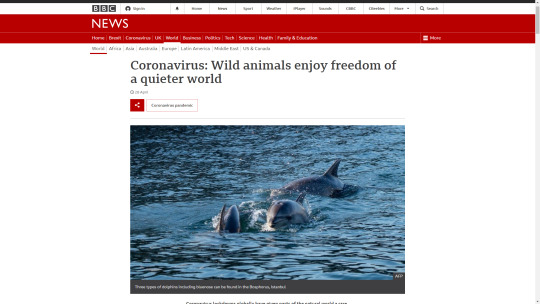
https://www.bbc.co.uk/news/world-52459487
In Istanbul, dolphins venture closer to the banks as what was normally one of the worlds busiest marine routes came to a temporary halt as fishermen stayed home during the city’s lockdown.
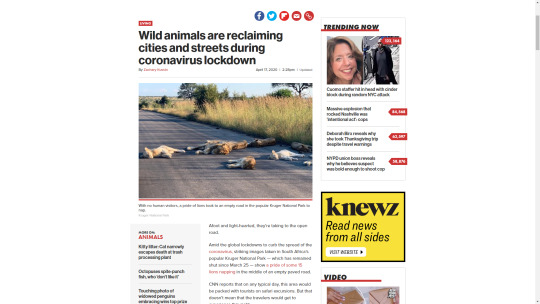
https://nypost.com/2020/04/17/wild-animals-are-reclaiming-cities-during-coronavirus-lockdown/

https://www.thesun.co.uk/news/11302340/animals-reclaiming-planet-coronavirus-lockdown/
According to this article, animals moved more into the city as they sensed less noise, so they venture in to find food in the empty city and depending on the size of the city, some get lost. In some areas like Wales, police say that the animals did not need to be escorted out as they usually found their own way back

https://www.theguardian.com/world/gallery/2020/apr/22/animals-roaming-streets-coronavirus-lockdown-photos
I like this article as it mainly contains a series of photographs from different countries, capturing the moment of adventure.
youtube
LITTER IN THE UK:
Although it seamed as if the World was going through a natural “cleanse” and nature reclaiming itself, it wasn't long before humanity struck back for their ‘freedom’ from isolation. As if it was fate bestowed by the gods, the ease of lockdown in the UK from the 4th July gave the Brits their long awaited summer. Despite the ongoing pandemic, people from major cities vacate to the peaceful countryside and public beaches to soak in their short lived heat wave.
youtube
youtube
Beaches such as Brighton and Bournemouth felt the greatest impact.
youtube
Aftermath of Bournemouth beach. The disturbing video above shows just how careless, selfish and irresponsible people are when it comes to looking after themselves.
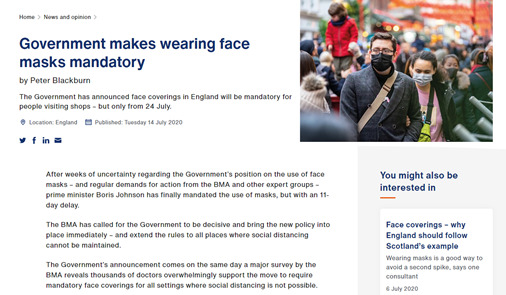
https://www.bma.org.uk/news-and-opinion/government-makes-wearing-face-masks-mandatory#:~:text=The%20Government%20has%20announced%20face,but%20only%20from%2024%20July.
From 24th July, the Government announced that wearing masks would be mandatory to those going to shops and restaurants in order to lower the chances of injection, and advised to use hand sanitizers or sanitation wipes on surfaces before entering. But, little did they know how irresponsible Brits would cause a backfire on the environment.
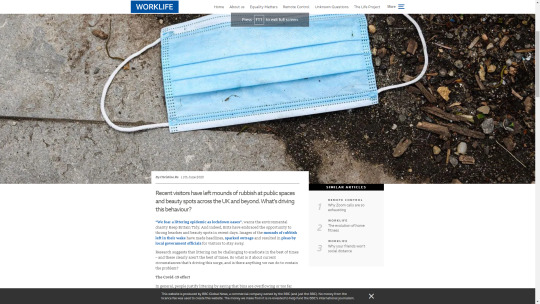
https://www.bbc.com/worklife/article/20200610-why-are-parks-full-of-litter-as-lockdown-eases
Christine Ro’s article states “Like every other aspect of our everyday lives, rubbish and recycling collection has been disrupted in some places by the Covid-19 pandemic. This context is crucial because waste disposal depends on “social proof”, or the copying of others’ behaviour. “If you see a place that’s full of litter and a mess, you’re more likely to think that it doesn’t matter,” says coaching psychologist Stephen Palmer of the International Academy for Professional Development and University of Wales Trinity Saint David. “If you actually see someone dropping litter, you’re probably more likely to drop litter yourself.”
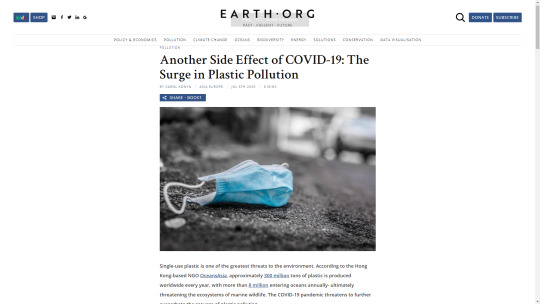
https://earth.org/covid-19-surge-in-plastic-pollution/
PLASTIC POLLUTION AMIDST COVID19
Naturally, the priority over the past few months has been mitigating the contagion of the virus, which includes the implementation of collaborative protective measures. Essential components to controlling the spread include the wearing of surgical face masks and the frequent disinfection of hands. Although these two measures alone cannot stop the pandemic, they play an important role in preventing infection and are therefore vital to controlling and eliminating COVID-19.
WHY THERE IS A CORRELATION WITH PLASTIC AND THE PANDEMIC
Both face masks and hand sanitiser production include the use of plastic. Face masks typically contain polypropylene (PP), which, due to the microfibers’ hydrophobic composition, acts as a protective layer against bodily fluid droplets. Other more intricate and expensive face masks include polyurethane (PUR) and/or polyacrylonitrile (PAN).
A UK-based charity, Keep Britain Tidy, fears a littering crisis amidst the relaxation of lockdown regulations and social distancing rules. With an increase in the number of people visiting beaches and parks, and gathering in public spaces, large amounts of rubbish have accumulated. Thames21, a charity that aims to maintain healthy waterways in London, suggests that people are socialising in a way that is different to before lockdown: mainly congregating outdoors. This has led to carelessness in behaviour displayed through littering, for example. Thames21 reports that the main type of rubbish found is single-use plastic, such as fast-food packaging, confectionary wrappers and drink bottles.
Keep Wales Tidy campaigners stress that significant amounts of personal protective equipment (PPE) are being littered across the country. In addition to being an environmental hazard, says Jemma Bere policy and research manager for the organisation, the littering of PPE poses a contamination risk to others: many samaritans that would typically collect litter when encountering some are no longer doing so to avoid the risk of coming into contact with contaminated PPE.
.... next source...
https://earth.org/covid-19-unmasking-the-environmental-impact/
written by: SUCHETANA MUKHOPADHYAY
These masks are mainly made of non-woven fabric such as polypropylene, which is between 20 and 25 grams per square metre in density. Polystyrene, polycarbonate, polyethylene or polyester are some of the other commonly-used materials in surgical masks. While they keep out bacteria effectively (although not necessarily that of the virus), the masks are plastic-based, liquid-resistant products that have a long afterlife after they are discarded, ending up in landfill or oceans.
Given that surgical masks are supposed to be worn for no longer than one day, their disposal- along with that of empty hand sanitizer bottles and soiled tissue papers- is leading to a massive trail of clinical waste in the environment. In Hong Kong, for example, which has been battling the coronavirus since late January, such waste has already started polluting the environment.
During a recent survey trip to Soko Islands, a small cluster of islands lying south-west of Lantau Island, Hong Kong-based environmental NGO OceansAsia found heaps of discarded single-use masks washed up on a 100-metre stretch of beach. According to Gary Stokes, founder and director of the ocean-centred NGO, which has been monitoring ocean surface trash as part of WWF’s Blue Ocean Initiative, their team has seen the odd mask here and there over the years, but this time they were spotted all along the high tide line and foreshore with new deposits coming in with each current.
“Due to the current COVID-19 outbreak, the general population have all taken the precaution of wearing surgical masks. When you suddenly have a population of 7 million people wearing one to two masks per day, the amount of trash generated is going to be substantial,” Stokes says.
The adverse environmental impact of such clinical debris during COVID-19 are far-reaching. Once these are left discarded in an animal’s natural habitat- be it land or water- this may cause animals to mistake this trash for food, which could lead to entanglement, choking, ingestion and death.
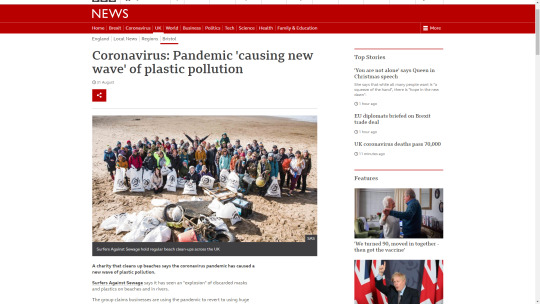
https://www.bbc.co.uk/news/uk-england-bristol-53947161
youtube
https://www.independent.co.uk/news/health/coronavirus-litter-warning-rubbish-transmission-government-a9617521.html
The beaches weren’t the only victims caused by certain individuals who are unable to look after themselves; this vile habit followed them back to their residing cities and violate the environment surrounding them. What makes this worse is that most people turn a blind eye this.
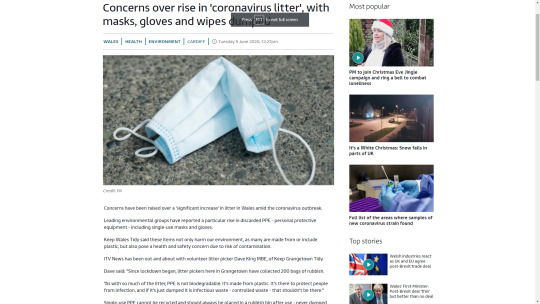
https://www.itv.com/news/wales/2020-06-09/concerns-over-rise-in-coronavirus-litter-as-people-discard-masks-and-gloves
How should I dispose of my waste during the pandemic?
Single-use personal protective equipment (PPE) is not recycled. This includes disposable face masks, gloves and aprons. The advice is to put it in your rubbish bin.
Personal waste, such as tissues and wipes, cannot be recycled and should be put in the bin.
If you or someone you live with has had symptoms of Covid-19, double-bag the items and leave them for at least 72 hours before collection.
Food and drink packaging, including plastic and glass bottles, are now largely recycled and should be put in your kerbside recycling box or bag.
Disinfect your recycling bags, boxes and caddy handles before and after use.
Larger household waste that cannot be collected kerbside should be taken to a local household waste recycling center, with appropriate guidelines followed.
0 notes